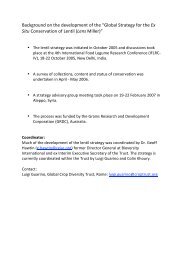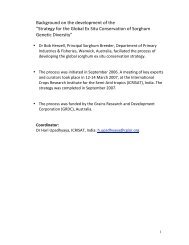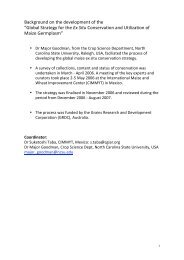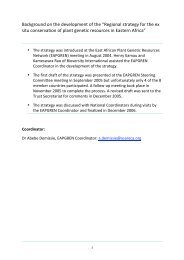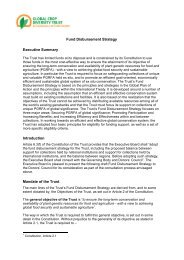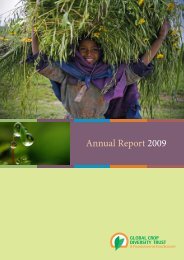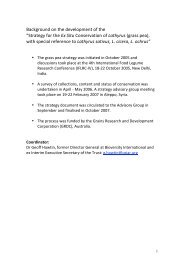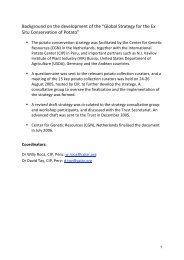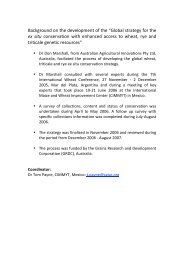Fusarium head blight, or scab, has already caused $3 billion in damage to<strong>the</strong> <strong>US</strong> wheat and barley industries. New sources <strong>of</strong> resistance are needed toprotect <strong>the</strong>se crops.The $1.8 billion <strong>US</strong> apple industry is vulnerable to destructive bacteriacausing <strong>the</strong> disease called fire blight, which is now showing resistance topesticides that once controlled it.All types <strong>of</strong> citrus cultivated in <strong>the</strong> U.S., where <strong>the</strong>y generate $2 billionannually, are vulnerable to diseases such as citrus canker and citrus blight.In each <strong>of</strong> <strong>the</strong>se cases, plant scientists are searching through domestic andinternational crop diversity collections to find genetic resistance to <strong>the</strong>se diseases.Once those sources are identified, breeders can begin developing new diseaseresistantcrop varieties.But <strong>the</strong> importance <strong>of</strong> crop diversity to <strong>US</strong> agriculture goes beyond <strong>the</strong> fight againstdisease. Farmers today also must have access to new crops and more diversity withineach crop family if <strong>the</strong>y are to stay abreast <strong>of</strong> a rapidly evolving market.<strong>US</strong> agriculture needs global collections <strong>of</strong> crop diversity to improve<strong>the</strong> health value <strong>of</strong> foods and to meet changing consumer demand.The United States Department <strong>of</strong> <strong>Agriculture</strong> (<strong>US</strong>DA) has noted several majorfood trends in America today: higher incomes are spurring demand for higherquality foods; an aging population wants healthier foods; increasing numbers <strong>of</strong>people want organically-grown foods; and an increasingly diverse populationdesires foods used in ethnic dishes. In each case, satisfying consumer demand willdepend on access to <strong>the</strong> genetic diversity <strong>of</strong> crops.For example, consumer interest in health has sent farmers in search <strong>of</strong> cropvarieties that have enhanced nutritional value, and for varieties <strong>of</strong> newly popularexotic produce that are adaptable to <strong>US</strong> growing conditions. Maintaining <strong>the</strong> rapidgrowth <strong>of</strong> organic food production in <strong>the</strong> U.S.—now an $11 billion industry—isespecially dependent on genetic variation. When disease or pests threaten, strictprohibitions on using pesticides or genetically modified varieties make naturallyobtained disease resistance one <strong>of</strong> <strong>the</strong> few alternatives available to organicfarmers.The United States has a stake in conserving global crop diversity as ameans to help solve <strong>the</strong> related problems <strong>of</strong> economic development,hunger, and environmental quality in <strong>the</strong> developing world.A United Nations (UN) report recently cited <strong>the</strong> importance <strong>of</strong> geneticallyimproved crop varieties and native crop genetic resources as a way to boostproduction on subsistence farms, where half <strong>of</strong> <strong>the</strong> world’s 800 million chronicallyhungry people now reside.<strong>Crop</strong> varieties stored in genebanks are also playing a prominent role in reinvigoratingagricultural production in areas hit by <strong>the</strong> 2004 tsunami and in post-SAFEGUARDING THE FUTURE OF U.S. AGRICULTURE vii
war Afghanistan and Iraq, just as <strong>the</strong>y did in Cambodia following <strong>the</strong> ravages <strong>of</strong> <strong>the</strong>Khmer Rogue and in Rwanda following that country’s ethnic genocide.There is clearly a large demand for <strong>the</strong> services provided by genebanks, whe<strong>the</strong>r tomaintain <strong>the</strong> economic vitality <strong>of</strong> <strong>US</strong> agriculture, meet constantly evolving marketdemands, or, by spurring recovery in areas suffering from war or natural disaster, toenhance global security.But international crop diversity collections are under stress, and global capacity isnot keeping pace with demands. For example, <strong>of</strong> <strong>the</strong> 1,460 facilities housingcollected materials, only 35 meet international standards for long-term storage. In1996, <strong>the</strong> UN’s Food and <strong>Agriculture</strong> Organization (FAO) reported that up to1 million <strong>of</strong> <strong>the</strong> 5.4 million samples held in <strong>the</strong> world’s collections aredegenerating, and that number has increased in <strong>the</strong> years since. Many collectionsare losing vast amounts <strong>of</strong> genetic material through mundane but devastatingevents such as power outages, a lack <strong>of</strong> resources to regenerate decaying seed inold collections, and disease spreading within collections.Broader recognition <strong>of</strong> <strong>the</strong> important role played by crop diversity collections isneeded to spur a concerted effort directed toward <strong>the</strong>ir conservation and use. Withall <strong>the</strong> modern pressures working to diminish crop diversity, now is also a time <strong>of</strong>exciting scientific discoveries that can greatly improve <strong>the</strong> performance <strong>of</strong>genebanks in assisting global agricultural production. In particular, <strong>the</strong> moleculartools <strong>of</strong> plant biotechnology allow scientists to screen plant samples for genes <strong>of</strong>interest and to <strong>the</strong>n isolate this material and use it to breed new, improvedvarieties.Conservation is forever.Ultimately, <strong>the</strong> responsibility for safeguarding <strong>the</strong> world’s collections <strong>of</strong> cropdiversity should fall to governments, international organizations, and <strong>the</strong> privatesector acting in partnership to conserve this international public good inperpetuity. The scope <strong>of</strong> <strong>the</strong> task, its long-term nature, and <strong>the</strong> need for genebanksto be easily accessible to researchers and farmers all require strong publicinvolvement.A solution is at hand. Established in 2004, <strong>the</strong> <strong>Global</strong> <strong>Crop</strong> <strong>Diversity</strong> <strong>Trust</strong> is onevehicle for sustaining this partnership. The <strong>Trust</strong> is an independent internationalorganization with <strong>the</strong> goal <strong>of</strong> assuring <strong>the</strong> long-term security <strong>of</strong> <strong>the</strong> world’s mostimportant collections <strong>of</strong> crop diversity. It is <strong>the</strong> product <strong>of</strong> a partnership between<strong>the</strong> FAO and <strong>the</strong> 15 <strong>Future</strong> Harvest Centers <strong>of</strong> <strong>the</strong> Consultative Group onInternational Agricultural Research (CGIAR). The <strong>Trust</strong> is building a $260 millionendowment, through donations from national governments, philanthropicfoundations, and private corporations, <strong>the</strong> interest income <strong>of</strong> which will be used t<strong>of</strong>und <strong>the</strong> costs <strong>of</strong> crop diversity conservation into perpetuity, as well as to salvagecollections at risk and build <strong>the</strong> capacity <strong>of</strong> developing countries to manage <strong>the</strong>ircollections.In an age when all agriculture is interconnected—whe<strong>the</strong>r by trade, <strong>the</strong> exchange<strong>of</strong> genetic resources, or <strong>the</strong> spread <strong>of</strong> disease—<strong>the</strong> economic vitality <strong>of</strong> <strong>US</strong>viiiSUMMARY
- Page 1 and 2: Safeguarding the Futureof U.S. Agri
- Page 3 and 4: This report is published by the Uni
- Page 5 and 6: © CIATThe internationalgenebank at
- Page 7: crop disease in the United States m
- Page 11 and 12: Soybeans are growntoday on more tha
- Page 13 and 14: © USDA-ARSThe National Center forG
- Page 15 and 16: ox 1 (cont.)Major National Collecti
- Page 17 and 18: © USDA-ARS, Scott BauerThe strawbe
- Page 19 and 20: can only be done with access to gen
- Page 21 and 22: © E. Fouré, INIBAPA major threat
- Page 23 and 24: cause a devastating stalk rot. The
- Page 25 and 26: Plant scientists with the USDA and
- Page 27 and 28: Apple scab (caused by Venturia inae
- Page 29 and 30: unavailable. Control of aphids has
- Page 31 and 32: © USDA-ARS, Keith WellerFoods like
- Page 33 and 34: YES, We Have Bananas, and Plaintain
- Page 35 and 36: Seminis Seeds: Breeding Healthbox 3
- Page 37 and 38: © IPGRI, Amanda KingProviding poor
- Page 39 and 40: © FAO, P. Lowreyhandicapped by poo
- Page 41 and 42: agricultural sector. When Khmer agr
- Page 43 and 44: © USDA-ARS, Scott BauerA study has
- Page 45 and 46: former Soviet Union and Eastern Eur
- Page 47 and 48: The first was an analysis of the ec
- Page 49 and 50: give more attention to plant geneti
- Page 51 and 52: © IPGRIEnsuring that cropdiversity
- Page 53 and 54: every year, rather than replant the
- Page 55 and 56: Footnotes1234567J.L. Sherwood, J. F




